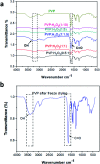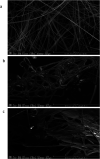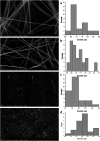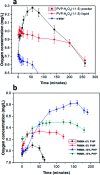Novel oxygen-generation from electrospun nanofibrous scaffolds with anticancer properties: synthesis of PMMA-conjugate PVP-H2O2 nanofibers, characterization, and in vitro bio-evaluation tests
- PMID: 35479904
- PMCID: PMC9033669
- DOI: 10.1039/d1ra02575a
Novel oxygen-generation from electrospun nanofibrous scaffolds with anticancer properties: synthesis of PMMA-conjugate PVP-H2O2 nanofibers, characterization, and in vitro bio-evaluation tests
Abstract
Released oxygen plays a critical role in reducing destructive tumor behavior. This study aims to utilize decomposed hydrogen peroxide as an oxygen source by conjugating it with polyvinylpyrrolidone (PVP). PVP-hydrogen peroxide complex (PHP) composed of different ratios of (PVP : H2O2) (0.5 : 1, 1 : 1, 1 : 1.5, 1 : 5, and 1 : 10) were successfully synthesized. PHP complex with a ratio of 1 : 1.5 was chosen as the optimized ratio, and it was incorporated into the polymethyl methacrylate (PMMA) nanofibrous scaffold via the electrospinning technique. Results have revealed that the PMMA-10% PHP complex provided a significant morphological structure of nanofibrous scaffolds. The mechanical properties of PMMA-10% PHP nanofibers showed the most suitable mechanical features such as Young's modulus, elongation-at-break (%), and maximum strength, in addition to the highest degree of swelling. All PHP complex scaffolds released oxygen in a sustained manner. However, the PMMA-10% PHP complex gave the highest concentration of released-oxygen with (∼8.9 mg L-1, after 2.5 h). PMMA-10% PHP nanofibers provided an ideal model for released-oxygen scaffold with anti-cancer effect and high selectivity for cancer cells, especially for breast cancer cells. Nanofibrous scaffolds with different composition revealed high cell viability for normal cells. Such outcomes support the suitability of using synthesized nanofibrous scaffolds as released-oxygen biomaterials to enhance cancer cells' sensitivity and maximize the treatment effect.
This journal is © The Royal Society of Chemistry.
Conflict of interest statement
There are no conflicts to declare.
Figures












References
LinkOut - more resources
Full Text Sources

